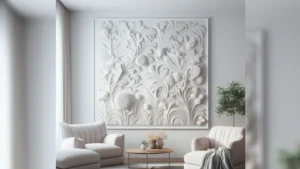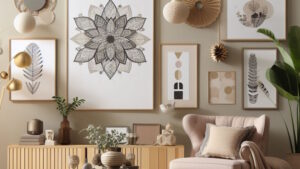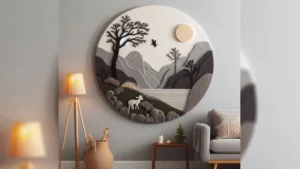Plaster Wall Art Sculptures allow you to transform any room with unique three-dimensional art pieces that add visual interest and character. Unlike traditional wall hangings like paintings or prints, plaster wall sculptures protrude from the wall to create dramatic focal points.
With the right placement, lighting, and accents, plaster wall art can completely change the look and feel of your space.
In this Nousdecor guide, I, Mark Cutler, will cover everything you need to know about plaster wall sculptures – from different styling options to installation tips.
With the help of this guide, you’ll be able to find the perfect sculptures to achieve your decor goals, whether that’s adding bold geometric shapes to a modern living room or ornate floral designs to a traditional dining room.
Key Takeaways
- Plaster wall sculptures add visual interest and character, unlike flat wall art. The 3D protruding shapes create unique focal points and dimensions.
- From minimalist geometric shapes to intricate floral designs, plaster wall sculptures come in many different styles. Consider the existing decor when selecting a style.
- Proper lighting can emphasize the depth and textures of plaster wall sculptures. Use accent lighting or spotlights to create dramatic shadows.
- Most plaster wall sculptures can be installed using construction adhesives or screws. Ensure the wall can support the weight before installing.
- Paint, patina finishes, and decor accents can be used to blend plaster wall sculptures with the overall decor scheme for a cohesive look.
The Allure and Benefits of Plaster Wall Art Sculptures
As a long-time interior decorator and home design expert, I am always on the lookout for striking decorative accents that can transform a space. In my years of experience, I’ve found plaster wall sculptures to be one of the most dramatic and effective options for adding intrigue to any room. But what exactly makes plaster wall art so special?
Here are some of the key benefits that make plaster wall sculptures a go-to choice for impactful decor:
- Adds dimension: Unlike flat art prints or paintings, creating 3D wall art with plaster at home adds depth and protrusion that you can’t achieve with a normal wall hanging. This creates visual interest and makes it an automatic focal point.
- Texture and depth: Plaster is a material that holds imprints and textures very well. Sculptures made from plaster have incredible hand-crafted depth and textures that add to the visual appeal. From smooth undulating curves to rough uneven edges, the textures alone can make a statement.
- Customizability: Plaster can be molded, shaped, painted, finished, and customized in so many ways. This allows for tons of unique design options to match your needs. Want an ornate baroque frame around your sculpture? No problem – plaster makes it possible.
- Lighting effects: The protruding shape and surface textures of plaster wall art interact beautifully with light. The use of well-placed accent lighting or spotlights can emphasize the depth and create striking luminous effects.
- Focal point: With a plaster sculpture jutting from the wall, it naturally draws the eye and creates a strong visual focal point in your space. This is especially powerful in a minimalist room with clean lines and empty walls.
So in summary, if you want to add palpable texture, depth, lighting effects, and custom art focal points to your decor, plaster wall sculptures are a versatile and stunning option. The 3D protruding shape makes it far more special than any basic wall print or painting. Let’s now look at the many gorgeous styles available.
Styles of Plaster Wall Sculptures
Plaster as an art medium is highly flexible and adaptable. It can be crafted into smooth modern shapes, intricate organic forms, or any style in between. When selecting a plaster wall sculpture for your home, consider the existing room decor and architectural details. The sculpture should enhance your space, not clash with it.

Here are some of the most popular plaster wall sculpture styles and what rooms they best suit:
Modern Geometric
Defined by clean lines, shapes like squares, rectangles, circles, and triangles, smooth surfaces, and an often monochromatic color scheme. Perfect for:
- Contemporary living and dining rooms
- Mid-century modern bedrooms and offices
- Minimalist apartments or homes with modern architecture
- White plaster wall art large-scale sculptures
- Unique plaster flower wall art projects
Organic and Floral Shapes
Flowing, asymmetric, plant-inspired shapes and designs that mimic flowers for crafting your own plaster flower wall art and vines, leaves, branches, or nature themes. Perfect for:
- Boho or eclectic living rooms and bedrooms
- Traditional dining rooms and libraries
- French provincial or cottage spaces
Portraits and Figurines
Sculpted busts, faces, full figures, or body parts and limbs add an almost surreal element. Perfect for:
- Large entryways and stairwells
- Art studios, creative offices, or musicians’ spaces
- Statement pieces in living rooms
Architectural and Ornate Details
Intricate shapes and designs inspired by columns, accents, frames, archways, and other architectural elements. Perfect for:
- Traditional formal dining and living rooms
- Entrance foyers and hallways
- Libraries, studies, and home offices
As you can see, plaster wall art comes in endless styles. So take stock of your existing room decor and architecture before choosing a sculpture to complement it. I always recommend having a clear vision of where you want to install the piece so you can select the right size, shape, and style.
Artful Lighting for Plaster Wall Sculptures
One of the keys to maximizing the visual impact of a plaster wall sculpture is proper intentional lighting. The way light interacts with the protruding shape and textural surface of a sculpture can make it truly captivating. Here are some lighting techniques I recommend:
Spotlights and Sconces
Strategically angled spotlights or wall sconces with bulbs that point toward the sculpture will cast dramatic shadows, especially if the wall itself is darker. I like to light sculptures from above and the side to showcase the depth and dimensions.
Backlighting
For a silhouette effect, place a light source behind the plaster sculpture so it appears as a projected shadow profile on the wall. Use accent tables or standing lamps to easily create this backlight.
Accent Lighting
Use accent lighting like recessed fixtures or track lighting to illuminate the sculpture from multiple flattering angles. Accent lighting adds depth and emphasis so details and textures pop.
Natural Light
Consider the room’s natural light source. If possible, position the plaster sculpture so daylight streaming in from windows grazes across it to highlight the contours.
Take the time to test out different lighting scenarios to determine what brings out the best attributes of the specific sculpture’s shape and textures. Proper illumination can take plaster art from ordinary to extraordinary.
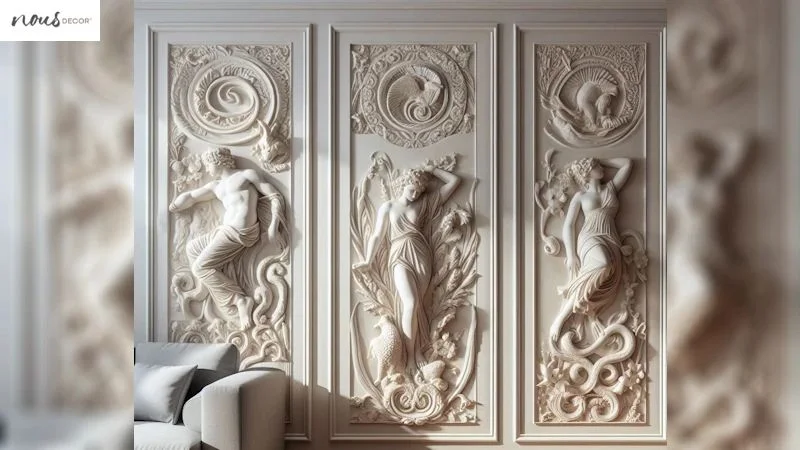
Tips for Installing Plaster Wall Sculptures
Once you’ve selected the perfect plaster wall art for your space, it’s time to install it properly so it appears to seamlessly emerge from the wall itself. Here are my tried and true installation tips:
- Assess the wall – Make sure the wall you want to install on is smooth, sturdy, and can support the sculpture’s weight. Plaster itself is quite heavy so take this into account.
- Use construction adhesive – Adhesive is better than nails or screws alone to affix the sculpture base firmly to the wall and prevent sagging over time. Apply the adhesive generously.
- Reinforce with screws – In addition to adhesive, I recommend using a few long drywall screws drilled into wall studs for very heavy sculptures. This adds extra reinforcement.
- Work in sections – If the sculpture has multiple sections, install each section individually using adhesive/screws rather than assembling all pieces on the ground first.
- Conceal hardware – Any visible hardware like screwheads can distract. Use plaster filler then sand and paint over screw holes to achieve a flush seamless look.
- Illuminate shadows – Shine light into any gaps between the sculpture and the wall to check for excessive shadows or debris. Fill any gaps with plaster filler for a clean professional appearance.
- Caulk edges – Use the painter’s caulk along the bottom edge where the sculpture meets the wall to smooth any imperfections for a streamlined silhouette.
Take it slow and steady – good plaster wall art installations are meticulous and detail-oriented. Put in the prep work for a seamless installation that makes the art appear molded into the wall itself.
Design Styling Tips and Accent Pairings
With the sculpture mounted, now comes the fun part – dressing and decorating around it! Here are some of my favorite styling ideas and complementary accents:
Paint Color
Choose a wall color that makes the most of your sculpture’s silhouette for proper contrast. For light sculpted shapes, go for moody dark paint colors. Bold or colorful sculptures will pop against a neutral palette.
Picture Lights
Mount decorative picture lights above the sculpture to add illuminated flair. Go for sconces with crystal teardrops or ornate metallic shapes. Picture lights amp up the glam factor.
Flower Arrangements
Fresh flower designs in vases or pots add color next to plaster sculptures. Opt for blooms and greenery that complement the sculpture’s colors and style. Avoid overwhelming the art with chaotic florals.
Mirrors
Frameless rectangular leaning mirrors can reflect light beautifully off the sculpted surfaces. Mirrors also subtly help blend and marry the sculpture with its surroundings.
Coordinating Accessories
Add accent pillows, throws, decor, ceramics, or objects in colors pulled from the plaster sculpture. Metallic decor that picks up the room’s light fixtures also nicely ties everything together.
Take the time to step back and view the art from afar within the whole space. Make small adjustments to paint, lighting, and accessories until you achieve the perfect cohesive look. Your new striking plaster focal point deserves a well-styled and coordinated surrounding space!

Frequently Asked Questions
Conclusion
Adding a plaster wall sculpture is a fantastic way to infuse any room with artistic flair and striking focal points. With limitless customization options and styles, you can certainly find the perfect wall art to liven up your living space. Just be sure to assess your room decor and lighting to select a sculpture that enhances your current aesthetic.
I hope this comprehensive guide has provided you with inspiration and actionable tips to integrate beautiful plaster sculptures into your home decor. Trust me, every guest who encounters your new jaw-dropping statement piece will be begging to know where you got it!
So go ahead – sculpt your ordinary walls into unique wall art ideas for home and enrich your home’s style with dimensional decor.

